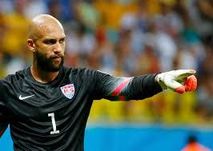|
With no clue about the glories about to unfold, my nerves were kicking in, 12 hours before kickoff.
I was obsessing about the starting lineup – and the formation – and the deep hole in the standings for the American men’s soccer team. I could not summon any of this fear and trembling for the just concluded World Baseball Classic, but on Friday, as the U.S. prepared to play Honduras in San Jose, Calif., I was worried if Tim Howard’s injury and Clint Dempsey’s heart issues would allow them to go full-tilt-boogie. I was looking forward to Bruce Arena’s return as head coach. I was worried about the injuries that have decimated Arena’s player pool. This is true national sporting fear, known to soccer fans around the world, and now a very real tradition in the United States. Then the U.S. displayed the get-out-of-jail-free card and welcomed back Dempsey and Howard and Arena with a 6-0 romp over Honduras. How often, in motion sports like soccer, basketball and hockey, do players display initiative at the changing of a coach? From the whistle, the U.S. was energized and creative. The first sign was relatively new players like Darlington Nagbe (speed, brains and low-to-the-road center of gravity) opening up the field. He was followed by Christian Pulisic and Sebastian Lletget, displaying freedom to find space, to take their shots. And then Dempsey, his glower intact after a bout with arrythmia, scored a hat trick. And Michael Bradley turned and launched a long left-footed goal that reminded me of Jermaine Jones' surprise blast in the last World Cup. And Howard was back in goal, his bald head sweating in a prolonged pre-game practice, his eyes giving direction to his defenders. What I am saying is, in my own home, liberated by retirement to be a fan, I loved it. Now I can start obsessing about the match in Panama Tuesday. I could not summon anything like this for the final of the recent Classic Tuesday although I enjoyed watching a compelling young U.S. pitcher, Marcus Stroman, shut down Puerto Rico in an 8-0 victory. From reading the terrific analysis by Billy Witz in the Times on Friday, I see the American players have reacted negatively to the emotion shown by fans and players from Latin America and Asia. The excitement is cultural….and it is the future of the Classic….but I can understand what the U.S. players are feeling. They are from Major League Baseball, the best league in the world, and so are most of their opponents. In a few weeks they will be playing official games and I will have knots hoping Yoenis Céspedes can hold up all season and most of the young pitchers will be healthy and what adventures will befall our beloved Weepin’ Wilmer Flores. Allowed to shed neutrality, I get tied into knots for my home-borough Mets, not for an all-star national team in March. My friend Clemson Smith Muñiz, editor of a terrific new site on Latin baseball, explains my inner dichotomy: “Hola, George, the irony of the WBC final was Latinos had skin on both side of the field. Team USA starting pitcher Marcus Stroman's mother is from Puerto Rico; third baseman Nolan Arenado's father is Cuban and his mother Puerto Rican; and first baseman Eric Hosmer's mother is Cuban. Yes, it took a ‘Half-Rican’ to beat the undefeated ‘Quarter-Rican’ Seth Lugo and the rest of the Boricuas.” Plus, the stirring Puerto Rican team, with its dyed blonde hair and accent marks on the back of the jerseys, consists of beloved and respected players from the long season: venerable Carlos Beltrán and dynamic Yadier Molina, players we love to watch all season (except maybe when they help crush the Mets.) Those emotions are ahead of us. But ever since Paul Caligiuri’s goal in Port of Spain in November of 1989, the U.S. has had the feel of the World Cup -- the men’s quadrennial struggle to qualify, the women’s reign of excellence, now in decline. Qualifying is brutal – hard faces on Latin players, coming to American soil with much to prove, flying objects and language in ominous places like Azteca Stadium, inexplicable official decisions on the road. The stuff of horror movies. Maybe the World Baseball Classic will get there some day. Right now, I knew true sporting fear – meaningless, but tell that to my nerves.
bruce
3/25/2017 12:27:12 pm
george,
George Vecsey
3/25/2017 01:01:55 pm
Bruce, very true. FIFA allots 3 1/2 slots to Concacaf (regional conference) It's all about TV audience and corporate sponsors. Follow the money. When the New Blatter expands World Cup, I bet this region gets 4-5-6 slots. Once in a while USA or Mexico or Costa Rica wins a match in the WC final tournament, but the time has not come yet. GV
Ed Martin
3/26/2017 08:25:49 pm
Enjoy! (As we say around NYC- usually in front of a blintz or pastrami sandwich, but US soccer counts, too.)
George Vecsey
3/27/2017 08:45:21 am
Ed, the Mets (and other baseball teams) play every day, so the terror is spread out -- slumps, wretched games, and sometimes even a liberating acceptance that this is NOT next year. 3/27/2017 10:46:13 am
Coaching does make a difference. This is true at all levels of sports.
George Vecsey
3/27/2017 11:53:48 am
Alan thanks for the comment. I haven't spoken with Arena since the return, but I saw him on TV. Asked if he was a better coach now, he smiled and said quite quickly, yes, he was. He always treated his players like adults (staying in hotels in Seoul and Hamburg during World Cups) but had gotten cranky by 2006. It's funny about Klinsmann. Many Germans thought he was a moonbeam -- too much time in America -- but some US players seemed to think he was too stern. Every World Cup coach cuts somebody, or doesn't play him. Bruce seems to recognize that Pulisic has gifts...and is getting better from being in Bundesliga. See you soon G Comments are closed.
|
Categories
All
|











